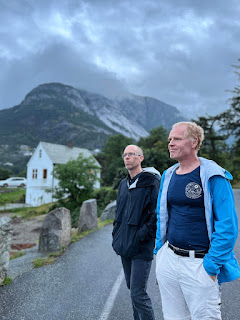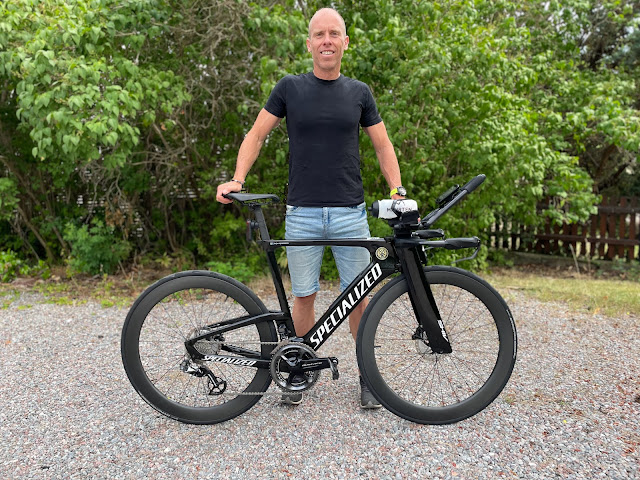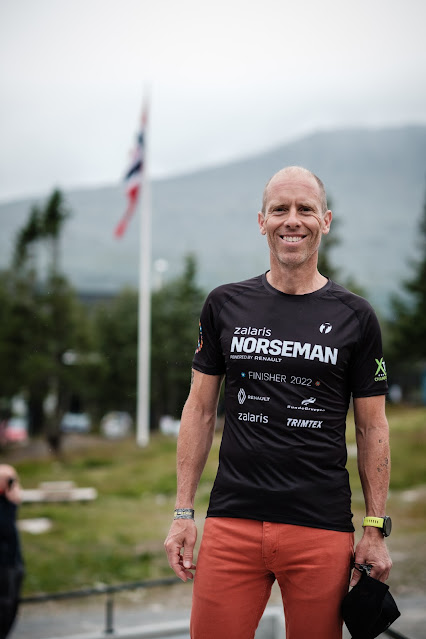Norseman 2022 - An Unforgettable Race
Preparation and planning
In 2019 I had finally come to the step where I was ready to sign up for a full distance triathlon race, and Ironman Italy was the choice. Nice sunny and warm weather, salty cozy Adriatic Sea for the swim, flat and fast bike course and easy run in Cervia to round it off. Combining it with Italian wine and food and some family fun at the same time, it felt like a perfect choice. When I got the message from my brother Peter shortly after mentioning that I had won an entry into Norseman and that the debut would be earlier, I was flabergasted...
Eidfjord - it looks so nice and innocent!
Norseman is the total opposite to Ironman Italy. It is famous for being one of the most extreme and difficult full distance races out there... Starting by jumping off the ferry at 5am into the ice cold fjord waters of Eidfjord, having to swim back to T1, then biking first up to Hardangervidda with a 40km long climb through tunnels and past waterfall, and then continuing up and down the Norweigan mountains accumulating a total of 3000+ meters of ascent and descent. Once the marathon run starts it is easy for the first 25km until you hit "Zombie Hill" - 8km of steep ascent up to the first run check point. At this place, only the first 160 participants are allowed to continue towards the mountaintop and finish on top of Gaustatoppen, another 10km climbing uphill towards 1800m altitude, with the final 5km along a stony mountain path where you need to bring with you a backpack with warm clothes, food, flash light etc. During the race there is no support given by the race organizer - so you need to bring your own support crew that will help you with equipment, clothing, food and drinks all the way, with at least one person accompanying you the final 5km up the mountain top. Weather is characterized by cold, wind, rain, fog, sun, snow...everything! To say the race is extreme is an understatement, and the moto of the race is indeed "This is not for you"! My heart fell a bit when I got the news I got a slot, I wasn't really planning for that...
Regardless - training started, and then Covid hit, so our race got postponed until August 2022. The race itself also required some extra logistics to plan for lodging, transportation, all gear needed (lots of cold weather gear...), food and drinks, race and support planning etc. But finally me and my support crew consisting of my brothers Thomas and Peter, plus my son Sebastian as an extra passenger were ready to head out to Eidfjord where the race start is.
Descending down to Eidfjord from Hardangervidda was magical - neither of us were prepared to the beauty and grand scale of the mountain walls and fjords, and it was difficult to take it all in.


So beautiful it hurts
I had managed to get a room at the race hotel that was at the dock where the ferry would leave on Saturday morning and 20m from T1 - just perfect. We had a family room where we could spread out all material and I had the possibility to go through the gear 20 times more, repack all bags and boxes a few more times or just chill out in the bed and get overall nervous as we got closer to the race.
Let me prove you wrong...
Thursday and Friday were otherwise spent doing a bit of sight seeing, a short run and bike check, some swimming in the inner parts of the fjord (13C in the water - a shock to the system!). We anxiously followed the weather report that finally settled in to 10C in the morning with light rain, 2C on top of Hardangervidda but with strong tail wind, eventually ending up with 10-12C on the bike and finally around 15-20C on the run with sunshine. Manageable I thought...

Easy run and social swim, meeting with the Norseman crew
Last night with all things prepared I went to bed at 9pm with the alarm going off at 2.20am. Me and Peter went down to T1 to check in the bike, then a quick breakfast and at 4am the ferry departed with the 275 racers onboard out into the early morning, with the rain drizzling from a heavy sky. Time to get going...
Swim
The ferry anchored up at around 4:30am and I just had time for a last bathroom break before suiting up. Walking out to the ferry jump point you get drizzled down by some sea water to get used to the temperature.
The dark night sky had now started to lighten up and you could in the distance see Eidfjord where T1 was. Without much hesitation I made the jump into the 15C water and swam the 150 meters to the start line just by the fjord wall. You could see a few spectators up on the road, the safety canoes and the ferry starting to make its way back to Eidfjord.

Based on my swimming in Sweden and the testing in Eidfjord the days before, I had decided to swim in my normal wet suit (I had no other choice there...), a neopren cap as well as short socks. We had swum some 20 minutes before, and the temperature then felt manageable for the estimated 1:15 hour swim. But treating water waiting the few minutes until the start horn sounded, I already started to feel cold. Very cold...
I staggered up from the water shivering to the bone and was greeted by Peter who was going to help me in T1. I let out some Swedish swear words regarding the cold and manage to hear that I was at around place 95 after the swim - better than expected. Thankfully I didn't get a time - the swim had taken 1:19 hours, well above my plan, but at that time I was just happy that I had survived.
Bike
The transition took a long time (11 minutes!) as I was wet, which makes it difficult to get clothes on, and I couldn't move my fingers at all, making it difficult to get on the upper layers of clothing (my fingers got stuck!). But me and Peter methodically worked through the steps we had agreed on. The clothing plan was based on my experience from winter gravel biking and knowing it was going to be 2C at the top, plus some light rain the first hours.
On the top I had my race suit that I had swum in, long windproof arm warmers, a rain/wind jacket plus a reflective vest, thin ski gloves with waterproof covers. A thin beanie under the helmet. Below I had long compression socks, knee covers plus water covers for the shoes.
I chose to use my TT bike, but slimmed down as much as possible in weight. There are no flat sections on the course, only steep ascents or descents. The aero profile helped me downhill, and low weight was an advantage uphill, stripping of some covers and minimizing spares and bottle sizes on the bike. I was very grateful to have disc brakes as there are plenty of sharp corners on the hills. On the cassette side I had installed a 11-30 which was just perfect, there were just a few times I had to stand up to get above the steepest sections.
Working up the first section of the valley I got some warmth back and I was staying calmly at an effort around 200-210W according to plan, nice and easy. I got passed by a few persons the first 20km, but after that I remained steady in position, so I felt no need to push the pace - getting into T2 at around place 100 was going to be good enough I thought. I worked myself up the Måbø valley, and it was truly magnificent with the steep, rain-ridden walls with clouds clinging to their sides. In and out of tunnels, making turn after turn, feeling the temperature dropping bit by bit. At Vøringsfossen we came into the real clouds and it started to get really wet, now half way up to the top of Dyranut. After 20km was the first allowed support position and I got a first new bottle of Maurten from my support team, although I had barely started drinking. From here it was another hour to the top (Dyranut) and it got chillier and chillier, but always working uphill kept the body warm until now. I had felt the need for a pee brake for a while, and I decided to do that just after the top, when a long descent into Geilo waited (50km downhill).
As soon as we passed Dyranut the rain stopped and we could see the cloud covers starting to ease up. But the wind was extremely strong (tail wind), and the cold just got worse and we got to hear that this year's edition was the coldest one on record temperature wise. Downhill I started to shiver again, especially when the wind crossed to the side or came in from the front, and at all times I had to focus to control the bike holding on tightly the bars. It was very seldom I had the courage to use the aero bars fully, it just felt too risky and I had no desire to crash on the bike again. With the cold and lack of sweating, the need to pee grew stronger and stronger again and I had to stop two times more before Geilo.
After about 1:15 hours descent and 3:30 hours total riding I finally got into Geilo (90km) where the temperature now had risen to 10C and the sun started poking through the clouds, giving some extra warmth. The second half of the course consists basically of four mountain passes: 3, 4, 5 and 7km ascents of 6-8% grade with long sweeping descents in between. No flat sections at all. This means that the biking becomes some kind of "sweet spot" intervals: 15-40 minutes of stead effort followed by 5-20 minutes of rest downhill holding on for dear life. As I knew I was around position 90ish in Geilo, I didn't feel any pressure to push the pace or take positions, and when I took it relatively easy uphill I slowly overtook a few persons every hill, giving some extra comfort in my position. As I never really got tired, I started to enjoy the biking - sun was coming out, body was warm, I chatted with a few persons as I passed them, and I rolled down all the downhills choosing not to take any risks with excessive velocities (I anyway topped out at 70 km/hour). On each uphill I got a bit warm, to quickly get cold on the top and downhill, so I never felt the need to stop and change clothing saving me some time. At our planned support points the crew was waiting with new bottles, gels, banana and lots of cheering - so fun!
The last - and infamous - climb is up to Imingfjell with about 7km of 8% grade, meaning approximately 40 minutes uphill. A lot of people at this time start to feel the fatigue, but I felt just great and took a dozen positions uphill going easily and steady. After the final support point at the top of the hill and 152km, the only thing remaining is a long sweeping descent into T2. 25km of continuous descent, dropping 600 meters altitude. I again decided to take it really easy, not pushing my luck and saving my legs for the run. I got passed by five dare devils on the way down to T2, and finally after 6:45 hours on the bike came into T2 in position 75. The sun was shining and it was 20C in the transition site by the lake site - this was great!
Run
T2 was much easier as I was not frozen to the bone. Biking clothes off, cap and sunglasses on, a quick sip of Maurten and a gel, and off onto the run. Off course - first another pee stop just outside T2 before I could relax...
The run course is "interesting". It starts with 25km flat running along the lake and up the valley to Rujkan. After 20km you see the finish line for the first time when Gaustatoppen comes into sight. A truly impressive mountain wall, with the antenna tower by the finishing line barely visible. To get up from the valley to the mountain you have 17km of continuous ascent - first "Zombie Hill" seven kilometers to the cut-off point, then five kilometers to the mountain entry check point, and then the final five kilometers hiking up the mountain trail. The cut-off point allows the first 160 racers to continue up on Gaustatoppen, the remaining racers have to veer off to the Gaustablikk hotel and can finish off the race on a short loop to make the full distance. If you finish on Gaustatoppen you get a black finisher t-shirt, otherwise you get a white t-shirt. Everyone wants the black t-shirt, so you need to be top-160 after Zombie Hill, and you need to plan the run accordingly.
As I was 75th place out of T2 I was fairly certain of a top-160 at the cut-off, unless something crazy happened. So I kept to my plan - try to hold a 5 minute pace for at least 10km, and after that short breaks walking when receiving support. The run felt easy, and after 10km I decided to take 2km at a time. Every two km a few sips of Maurten, or a gel every eight km. As I felt good I decide to just continue, and soon set my sight to run all the way to Zombie Hill without stopping. The last five kilometers there is a slight ascent and as I was getting a bit tired the pace dropped a bit, but I was still taking a few positions every once in a while. I knew there was no need to push any pace which made it feel OK. Finally I arrived at the base of Zombie Hill, and after a change of shoes I could start walking uphill. Position 69 at the bottom with about one hour of margin to the person in place 160.

First view of Gaustatoppen
From Zombie Hill and to the finish it was too steep for me to run or jog, so the plan was to walk the rest of the way. Apparently I walk very slowly as I got passed by quite a few people, but I had enough margin to not get too nervous... From here on you're allowed one of your support to accompany you, so Peter and Thomas took turns walking with me uphill. They chatted, I mostly focused on walking upwards, especially as I had started to feel a bit nauseous after 20km.
I tried to continue to drink some water, take in some gels and eat something to not bonk, and a sip of Coca Cola made some magic eventually. After five hairpin turns and seven kilometers I finally made it up to the cut-off point, arriving in place 81, and now allowed to continue up to the finish line on Gaustatoppen.
Now it was only ten kilometers more - uphill... Nice and easy walk with Peter, chatting with the fellow athletes passing me, enjoying the view. As the temperature was dropping quickly it was nice to arrive to the mountain check point where Thomas and Sebastian were waiting with some warmer clothes for the final stretch up the mountain.

Together as a team we soldiered on up the trail, me being careful not to trip on the loose stones and Peter, Thomas and Sebastian chatting along trying to keep the mood up. The last kilometer seemed endless, but slowly the finish line with its flags and cheers came closer and closer. After 6:11 hours walking/running and a total of 14 hours and 32 minutes racing, finishing in 96th place, I would finally pass the finish line, smile for a few seconds before I slumped down and finally got some rest. I had earned my black finisher t-shirt together with my team.

On the top!
After the race
After a few sips of warm chicken soup and changing clothes again, I could take the small mountain train inside the mountain (the support crew had to walk down...) down to the parking lot and hotel. A long shower while waiting for the rest of the team, off for a late dinner while watching the final white t-shirt heroes finishing of their last laps, and when I fell asleep at the dinner table I could finally call it a day.
The next day we received our finisher t-shirts, and we fairly quickly made it off towards home with memories for life and a wonderful experience that we shared together.
A happy black t-shirt finisher
Overall the race went flawless. I did make a misstake in not having a warmer wetsuit, and drinking to much liquid in combination with the cold weather made me loose 20 minutes in pee stops (six stops in total!). But pace wise I stayed to my plan, I never felt overly tired and after the first four hours of cold racing I enjoyed the rest of the race. The setting and scene of the race is truly out of this world, and on top of this the organization of the race and the camaraderie of the participants is unique. A highly recommended race if you get the chance - although for myself I think once is enough!

























No comments:
Post a Comment